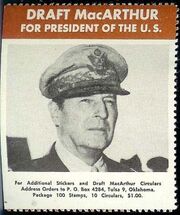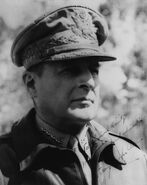| ‹ 1948 | ||||
| US Presidential Election of 1952 | ||||
|---|---|---|---|---|

|

| |||
| Nominee | Douglas MacArthur | Harry S. Truman | ||
| Party | Republican | Democrat | ||
| Home state | New York | Missouri | ||
| Running mate | Richard Nixon | John F. Kennedy | ||
| Electoral vote | 506 | 29 | ||
| States carried | 46 | 2 | ||
| Popular vote | 39,277,235 | 29,623,570 | ||
| Percentage | 57.0% | 43.0% | ||

| ||||
The United States Presidential Election of 1952 pitted incumbent President Harry S. Truman against his former general and subordinate, Douglas MacArthur. The election is often considered a vital part of the Cold War, since MacArthur's policies would effectively set the tone for the duration of the stand-off.
Background[]
Since 1932, and the start of the Great Depression, all Presidential elections had put a Democrat into the Presidency. This was largely the result of President Franklin D. Roosevelt's four terms as President, and then the term served out by his vice-President, Harry S. Truman.

Pressure was placed upon MacArthur to run for office
The primary issue of debate during the Presidential campaign was the recently concluded Korean War. Both political parties, the Republicans and the Democrats, believed that their candidate was responsible for the victories of the Korean War.
Pro-Truman supporters argued that their candidate successfully diffused a potentially difficult situation, and utilized the full abilities of the United States Armed Forces to prevent troops from dying.
Pro-MacArthur supporters, on the other hand, asserted that their candidate was the one who practically forced Truman to use an atomic bomb and end the warfare decisively for a democratic victory. MacArthur was regarded in high international esteem, and was favored publicly by both Sygman Rhee and Chiang Kai-shek.
Following MacArthur's return to America in 1951, he was promptly sought out by leaders of the Republican party to consider a bid for the presidency. After much deliberation, MacArthur agreed to run, pitting Commander-in-Chief and former General of the Army in a presidential race for only the second time. (The first being the Election of 1864, between McClellan and Lincoln.).
Democratic Primaries[]
The Democratic Primaries for the Presidency were unusually contested for a time when the incumbent could seek re-election. The most common belief is that a large number of Democrat politicians felt Truman was weak on communism, which would end up with his loss at the general election.
There were three candidates that announced their intentions to run for the Democratic party nomination. They were:

Truman announcing Kennedy to be his Running-Mate
Estes Kefauver was the primary challenger to Truman's re-election campaign. Kefauver was viewed nationally as a crusader against crime and communism, which was beneficial for his campaign but hurtful to Truman's attempt to be re-elected.
Truman managed to convince party bosses, who still had mafia ties, that Kefauver couldn't be trusted. Kefauver was effectively eliminated from the running prior to the convention due to the distrust between the leaders of the party and the candidate.
Barkley wanted to run, however he was viewed by the public as too old, and failed to receive a substantial backing going into the conventions. His decision to run, however, cost him the vice-presidential spot on Truman's ticket. Truman chose the young Massachusetts Congressman John F. Kennedy as his running mate, desiring to add youth and support in New England to his campaign.
Republican Primaries[]
The Republican Primaries for the Presidency were aimed at coming up with the most effective political leader to combat the Democratic party, which had held power in the White House since the election fo Franklin Delano Roosevelt in 1932.
Interestingly enough, the different Republican branches differed largely over main ideas. The conservatives were anti-Social Welfate and anti-Interventionist, the establishment was pro-Social Welfare and pro-Interventionist, and the moderates were anti-Social Welfatre but pro-Interventionist.
The main candidates were:
At first, the important Senator and former Presidential nominee Thomas Dewey attempted to "Draft Eisenhower", but as Henry Cabot Lodge, Jr., expressed his desire to "Draft MacArthur" caught on, Dewey ended up endorsing the war hero. Warren campaigned mostly only in the West, but MacArthur's popularity mitigated Warren's successes, leading Warren to drop out in late May, endorsing MacArthur, who was also a moderate.
As the Convention in Chicago approached, it became clear that MacArthur would gain the moderate and establishment nomination, and thus secure the chance to run. Taft was not considered for the Vice Presidency due to his old age, and MacArthur chose California Senator Richard Nixon, at the suggestion of Earl Warren.
General Election[]
Issues[]
The main issues of the Election of 1952 involved the emerging Cold War with the Soviet Union. The issues, as MacArthur's campaign put them, were "Communism and Corruption," stating his stance on the rise of the Communist bloc strongly and blatantly in many places. Rumors about communists in the Truman administration, as well as pointing to Truman's weak stance in Korea helped sell the Republican message.
Truman accused the Republican party to be filled with "fearmongerers," who would risk personal and civil liberties in order to protect their own political interest. Truman also accused the Republicans as being corrupt and pro-business. He attempted to hearken back to the years of Roosevelt.
Campaigning[]
MacArthur[]
As a result of MacArthur's extreme popularity, the election was widely anticipated (quite accurately) to be a landslide. Confident that he would be able to win the Republican strongholds in the Midwest, and knowing that Nixon had a broad appeal to Westerners, MacArthur, a Southerner, attempted to convice the "Solid" South that the Democratic Party was no longer on their side. This strategy, while effective in the long run, was met with only moderate success in the election of 1952.
From Chicago, MacArthur traveled in the northern states in the South, notably spending time in As a result, he undertook a large tour of the South, starting in Kentucky, then moving on to Tennessee, West Virginia and the Carolinas. MacArthur would later go on to visit most of the US, but would end his campaign where he started - the South.
Truman[]
Truman, weighed down with the responsibilities of the Presidency, faced a precarious position. If he campaigned too much, he would come across as power-hungry and as a person with a huge ego, yet MacArthur's widespread popularity promised a very dangerous challenge to the incumbent.
Results[]
The results of the US Presidential was a relative landslide for General Douglas MacArthur, who swept 41 out of 48 states. The seven states that voted for the Democratic ticket of Truman and Kennedy were:
- Missouri (Truman's home state)
- Massachusetts (Kennedy's home state)
- Alabama
- Kentucky
- South Carolina
- North Carolina
- West Virginia
Quite notably, a number of Southern states voted for a Republican ticket for the first time since the end of Reconstruction.
In total popular vote, MacArthur won a resounding mandate over incumbent Truman, gaining 9,653,665 million total votes. MacArthur generally won traditional Republican demographics, but also expanded greatly into the South where his dedication to preserving the social status quo earned him many supporters who were disgruntled by Executive Order 9981 and other anti-segregationist policies of the president.






